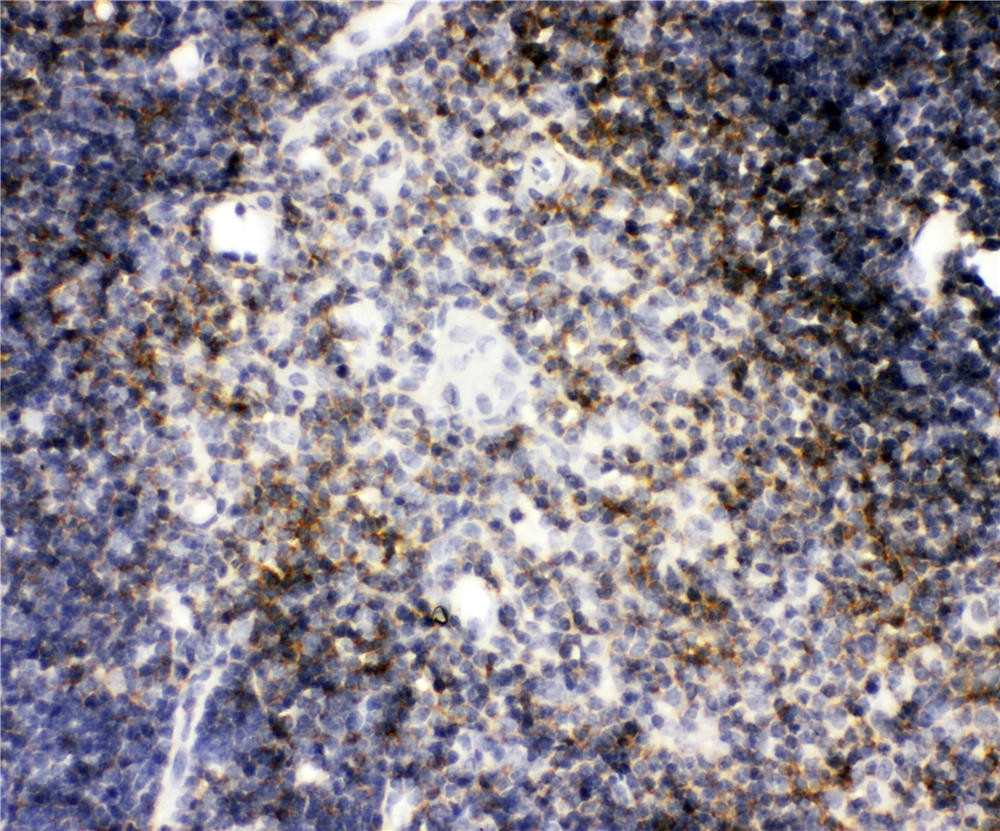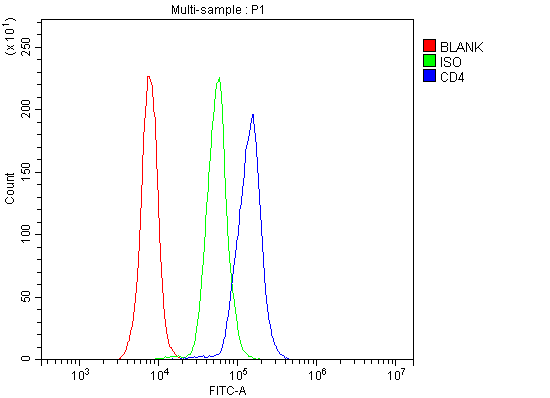| Western blot (WB): | 1:500-2000 |
| Immunohistochemistry (IHC): | 1:50-400 |
| Flow Cytometry (Fixed): | 1:50-200 |
| Enzyme linked immunosorbent assay (ELISA): | 1:100-1000 |

Western blot analysis of CD4 using anti-CD4 antibody (A00344-2). The sample well of each lane was loaded with 30 ug of sample under reducing conditions.
Lane 1: Mouse RAW264.7 whole cell lysates,
Lane 2: Mouse ANA-1 whole cell lysates.
After electrophoresis, proteins were transferred to a membrane. Then the membrane was incubated with rabbit anti-CD4 antigen affinity purified polyclonal antibody (A00344-2) at a dilution of 1:1000 and probed with a goat anti-rabbit IgG-HRP secondary antibody (Catalog # BA1054). The signal is developed using ECL Plus Western Blotting Substrate (Catalog # AR1197). A specific band was detected for CD4 at approximately 52 kDa. The expected band size for CD4 is at 51 kDa.

IHC analysis of CD4 using anti-CD4 antibody (A00344-2).
CD4 was detected in a paraffin-embedded section of mouse thymus tissue. Biotinylated goat anti-rabbit IgG was used as secondary antibody. The tissue section was incubated with rabbit anti-CD4 Antibody (A00344-2) at a dilution of 1:200 and developed using Strepavidin-Biotin-Complex (SABC) (Catalog # SA1022) with DAB (Catalog # AR1027) as the chromogen.

Flow Cytometry analysis of mouse PBMC cells using anti-CD4 antibody (A00344-2).
Overlay histogram showing mouse PBMC cells stained with A00344-2 (Blue line). The cells were fixed with 4% paraformaldehyde and blocked with 10% normal goat serum. And then incubated with rabbit anti-CD4 Antibody (A00344-2) at 1:100 dilution for 30 min at 20°C. DyLight®488 conjugated goat anti-rabbit IgG (BA1127) was used as secondary antibody at 1:100 dilution for 30 minutes at 20°C. Isotype control antibody (Green line) was rabbit IgG at 1:100 dilution used under the same conditions. Unlabelled sample without incubation with primary antibody and secondary antibody (Red line) was used as a blank control.

Western blot analysis of CD4 using anti-CD4 antibody (A00344-2). The sample well of each lane was loaded with 30 ug of sample under reducing conditions.
Lane 1: Mouse RAW264.7 whole cell lysates,
Lane 2: Mouse ANA-1 whole cell lysates.
After electrophoresis, proteins were transferred to a membrane. Then the membrane was incubated with rabbit anti-CD4 antigen affinity purified polyclonal antibody (A00344-2) at a dilution of 1:1000 and probed with a goat anti-rabbit IgG-HRP secondary antibody (Catalog # BA1054). The signal is developed using ECL Plus Western Blotting Substrate (Catalog # AR1197). A specific band was detected for CD4 at approximately 52 kDa. The expected band size for CD4 is at 51 kDa.

IHC analysis of CD4 using anti-CD4 antibody (A00344-2).
CD4 was detected in a paraffin-embedded section of mouse thymus tissue. Biotinylated goat anti-rabbit IgG was used as secondary antibody. The tissue section was incubated with rabbit anti-CD4 Antibody (A00344-2) at a dilution of 1:200 and developed using Strepavidin-Biotin-Complex (SABC) (Catalog # SA1022) with DAB (Catalog # AR1027) as the chromogen.

Flow Cytometry analysis of mouse PBMC cells using anti-CD4 antibody (A00344-2).
Overlay histogram showing mouse PBMC cells stained with A00344-2 (Blue line). The cells were fixed with 4% paraformaldehyde and blocked with 10% normal goat serum. And then incubated with rabbit anti-CD4 Antibody (A00344-2) at 1:100 dilution for 30 min at 20°C. DyLight®488 conjugated goat anti-rabbit IgG (BA1127) was used as secondary antibody at 1:100 dilution for 30 minutes at 20°C. Isotype control antibody (Green line) was rabbit IgG at 1:100 dilution used under the same conditions. Unlabelled sample without incubation with primary antibody and secondary antibody (Red line) was used as a blank control.




